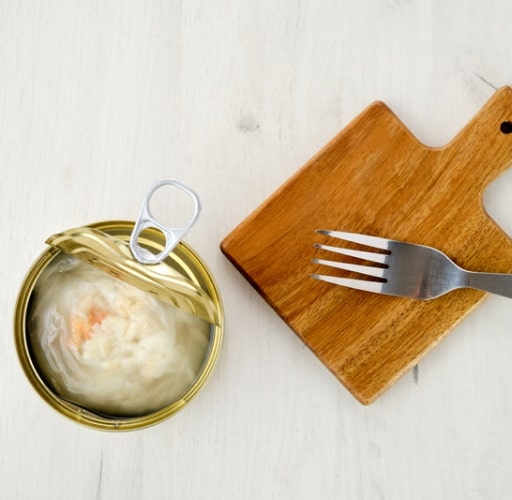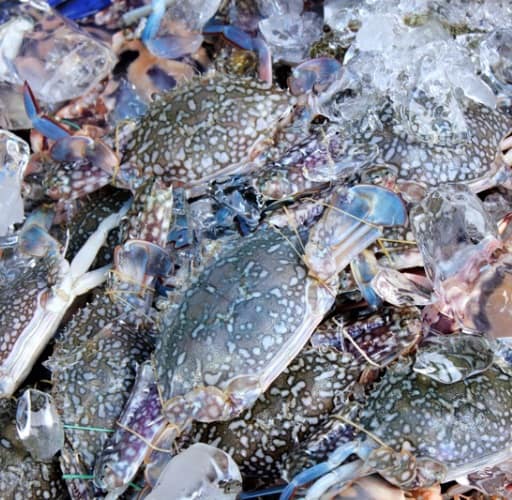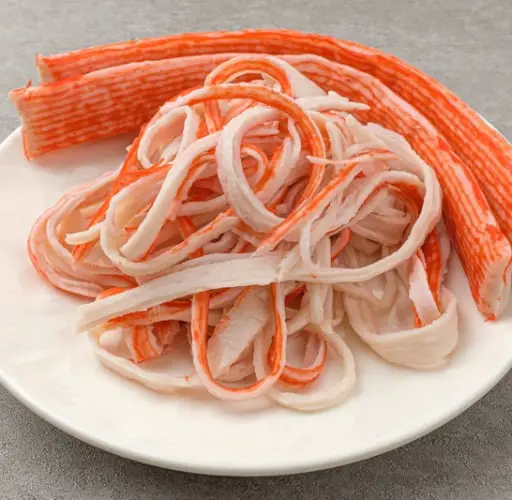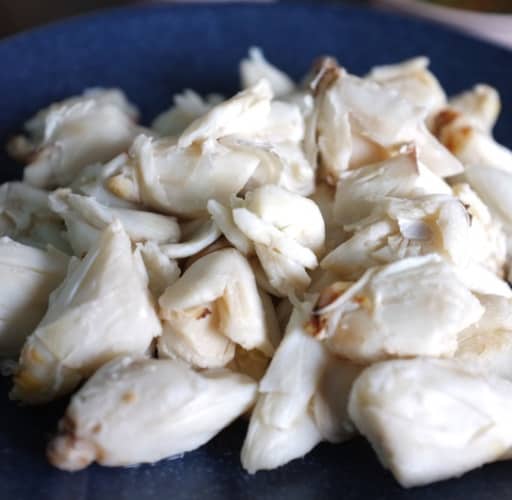Canned crab meat comes with a lot of convenience: it’s very easy to enjoy crab meat in a variety of ways without having to put in the effort of picking the meat directly from the shells.
But one common question that comes to mind for anyone who regularly consumes canned crab meat is whether or not it is cooked.
In this article, we’ll uncover the entire process of canning crab meat from ocean to facility, so you know exactly what happens to your favorite brand of canned crab meat before it hits the market shelves.
Hopefully, along the way, we’ll answer the question of whether the meat inside is fully cooked or not.

How Is Canned Crab Meat Made?
Canned crab meat isn’t just crabs caught and stuffed into cans and delivered to your local grocery stores.
The whole thing undergoes a series of steps at facility to make it very suitable for consumption.
Here’s a quick breakdown of how a typical canned crab meat is made.
Note that the exact process (in sequence) might vary slightly depending on brand, but the overall goal and key steps would still remain the same to achieve safety and quality.
So first, before anything, crabs are caught using various techniques such as using crab pots, dip nets, box, pyramid or ring traps or trawling and then stored in a refrigerated sea water on the fishing boat to maintain freshness until they reach the processing facility.

Upon arrival at the processing facility the live crabs are carefully inspected for quality, and any unsuitable specimens are discarded. This selection process ensures that only the highest quality crab meat is used for canning, which would further enhance the safety of the process.
After inspection, the crabs are then steamed or boiled in large industrial cookers until they are fully cooked to ensure that any potential bacteria and parasites are killed and also to make it easier to remove the meat from the shells. So there you have it, yes, canned crab meat is fully cooked during the processing.
Once cooked, the crabs are then cooled and the meat is manually and carefully picked by skilled workers from the shells (to prevent shells from making their way into the final product).
The crab meat is then sorted into various grades, such as lump, backfin or claw meat, or just weighed altogether and stuffed into cans or other suitable containers.
Then, the cans are vacuum sealed and then pasteurized — where they are heated to a specific temperature for a specified amount of time to eliminate any remaining bacteria and ensure a safe and shelf-stable product is distributed from the facility.
Special software programs can be used to monitor the sealing efficiency and any can that fails to seal properly would be discarded from the batch.
After pasteurization, the cans are cooled, (if not already labelled, printed with necessary details, and then packaged for shipping to grocery stores and other retail outlets.
Does Canned Crab Meat Need To Be Cooked?
Canned crab meat is already cooked when you buy it from the stores, so there’s really no need for additional cooking before consumption.
You can snack up on it straight out of the can without any preparation, although it wouldn’t be tastiest that way, and most brands even market their meats for use as an ingredient in various recipes like stuffed mushrooms, crab cakes, salads or even pasta and not as a snack on its own.
In some of these recipes, the crab meat may be cooked further, but this is done mainly for taste and texture, rather than for safety concerns.
Are You Supposed To Rinse Canned Crab Meat?
Yes, it’s generally a good idea to rinse canned crab meat before using it to help reduce the overall salt content, preservatives, as well as to remove other unwanted flavors that could make their way into the dish that you’re making.
In case you didnt know, crab meat, when canned and packaged on there own would not last a long time, and even if they do, won’t keep a firm and desirable texture or color.
In order to further extend their shelf life, preservatives such as Sodium Acid Pyrophosphates (SAPP), Disodium Pyrophosphate, citric acid, Calcium Disodium Edta, Sodium Metabisulfite, salt etc, are added to serve as a double layer of protection for preventing bacterial growth, formation of Struvite crystals, maintaining flavor, color, texture and firmness.
But these ingredients aren’t the best tasting ingredients in the culinary realm, and it’s a result, using the crab meat directly from the can can, to some extent, affect the taste of your dish, or even its sodium content.
In order to avoid that, it is advised to rinse the canned crab meat lightly (if not properly) under running water before purposing it for yourfavorite recipe.
Is Canned Crab Meat Real Crab? And Does It Taste Like Fresh Crab?
Canned crab meat is almost always made from real crab, although for some brands, a mix of crab species can be used (or sometimes real crabs can be used alongside surimi, which is a processed fish product designed to imitate crab — the whole idea of imitation crab).

It’s essential to check the label of your product to determine the specific contents of the canned crab meat you’re purchasing, but the likelihood is that it would always read, “crab” alongside other ingredients like sugar and water.
As for how it tastes, canned crab meat generally does not taste exactly like fresh crab, although it still retains the overall crab flavor profile.
The reason is because the canning process and the addition of preservatives alter, to some extent, the flavor and texture of the crab meat.

If you’ve been consuming fresh crabs for a while now, you’ll notice that it has a delicate, sweet and salty taste that is difficult to replicate in a canned product.
That being said, canned crab meat is still a very convenient and more affordable alternative to fresh crab for certain dishes such as crab cakes and dips, although you should steer clear of the rookie mistake of substituting canned crab (or even imitation crab) for fresh crab in a recipe that specifically calls for the latter, as the difference in taste and texture can affect the final outcome.
Does Canned Crab Meat Need To Be Refrigerated?
Unopened canned crab meat can typically be stored in a cool, dry place such as the pantry or cupboard, and it does not require refrigeration.
However, once you open the can, any unused crab meat should be transferred to an airtight container and stored in the refrigerator because the activity of spoilage bacteria must have already begun which will cause the product to go bad very quickly.
When properly stored, opened canned crab meat should be used within 3-4 days for optimal quality. After that time frame, begin to check for signs of spoilage, and if you discover any, make sure to discard the crab meat.
If you don’t plan on using the opened crab meat within that time frame, you can also store it in the freezer.
Place the crab meat in a freezer-safe container and follow up with a layer of plastic wrap or aluminum foil to prevent freezer burn. Make sure to label with the name of product and date of storage.
Frozen crab meat can last several months, but the quality may decline over time. When you’re ready to use it, thaw it in the refrigerator for best results.
Frequently Asked Questions
Is Bumblebee Canned Cranberry Meat Cooked?
Yes, Bumble Bee canned crab meat, whether lump or white is cooked and ready to eat right out of the can.
Almost all “canned” crab meat, as we have mentioned above including Bumble Bee’s, are fully cooked and then pasteurized to allow them to have a longer shelf life and ensure they are safe for consumption straight out of the can.
Regardless, you may still choose to heat or cook the crab meat further depending on your preference and the recipe you’re following.
Why Is There Paper In Canned Crab?
Not all canned crab products have paper in them, but if you do find a piece of parchment paper or a similar food-grade material between your meat and the can that contains it, it’s for the following reason: to prevent the formation of black discoloration on the surface of the meat due to the binding of the sulfur in the meat to the iron in the can which products ferric sulfide that causes the discoloration.
Finding paper in your canned crab meat may also be for another reason also, which is why it is recommended that you read the label and packaging information carefully for any information that may relate to that.

